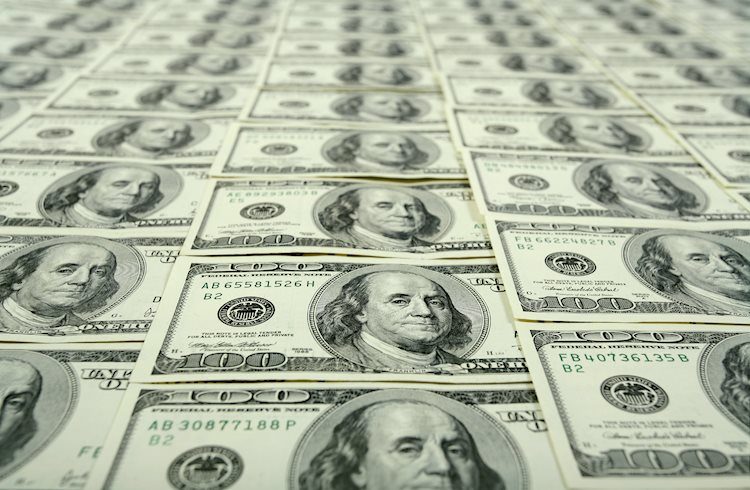- US inflation signals are cooling with PCE reading below expectations.
- Consumer sentiment has rebounded, indicating brighter economic expectations.
- USD might see additional downside if the markets remain stubborn on November’s 50 bps cut bet.
The US Dollar Index (DXY), which measures the value of the USD against a basket of major currencies, stands soft after the release of the US Personal Consumption Expenditures (PCE) data from August. The headline PCE inflation, the Federal Reserve’s (Fed) preferred inflation measure, came in softer than expected, while the core PCE inflation matched expectations.
Investors will be attentive to incoming data to continue placing their bets on the next Fed decision. Now focus shifts to September’s labor market data.
Daily digest market movers: US Dollar declines on soft PCE data
- Market is starting to pare back its Fed easing bets, with the market now pricing in 175 bps of total easing over the next 12 months vs. 200 bps at the start of this week.
- Headline PCE Price Index rose by 2.2% YoY in August, below market expectations of 2.3%.
- Core PCE Price Index, excluding food and energy, increased by 2.7%, matching consensus estimates.
- Consumer confidence in the US improved in September with the University of Michigan’s Consumer Sentiment Index edging higher to 70.1 from 66 in August.
- The five-year inflation expectation held steady at 3.1%, indicating that consumers do not expect inflation to rise significantly in the coming years.
- While dovish bets eased somewhat, the markets are pricing in a 50 bps cut for the next November meeting, which seems to weaken the USD.
DXY technical outlook: DXY signals bearish momentum, resistance at 101.00
Technical analysis indicates that the DXY index remains vulnerable to further declines as the Relative Strength Index (RSI) and the Moving Average Convergence Divergence (MACD) continue their downward trend and struggle to gather momentum. The 101.00 level continues to act as a strong resistance, capping the upside potential for the US Dollar.
Supports are located at 100.50, 100.30 and 100.00, while resistances are at 101.00, 101.30 and 101.60. The index’s inability to overcome the 101.00 level suggests that the downside momentum could persist in the near term.
Central banks FAQs
Central Banks have a key mandate which is making sure that there is price stability in a country or region. Economies are constantly facing inflation or deflation when prices for certain goods and services are fluctuating. Constant rising prices for the same goods means inflation, constant lowered prices for the same goods means deflation. It is the task of the central bank to keep the demand in line by tweaking its policy rate. For the biggest central banks like the US Federal Reserve (Fed), the European Central Bank (ECB) or the Bank of England (BoE), the mandate is to keep inflation close to 2%.
A central bank has one important tool at its disposal to get inflation higher or lower, and that is by tweaking its benchmark policy rate, commonly known as interest rate. On pre-communicated moments, the central bank will issue a statement with its policy rate and provide additional reasoning on why it is either remaining or changing (cutting or hiking) it. Local banks will adjust their savings and lending rates accordingly, which in turn will make it either harder or easier for people to earn on their savings or for companies to take out loans and make investments in their businesses. When the central bank hikes interest rates substantially, this is called monetary tightening. When it is cutting its benchmark rate, it is called monetary easing.
A central bank is often politically independent. Members of the central bank policy board are passing through a series of panels and hearings before being appointed to a policy board seat. Each member in that board often has a certain conviction on how the central bank should control inflation and the subsequent monetary policy. Members that want a very loose monetary policy, with low rates and cheap lending, to boost the economy substantially while being content to see inflation slightly above 2%, are called ‘doves’. Members that rather want to see higher rates to reward savings and want to keep a lit on inflation at all time are called ‘hawks’ and will not rest until inflation is at or just below 2%.
Normally, there is a chairman or president who leads each meeting, needs to create a consensus between the hawks or doves and has his or her final say when it would come down to a vote split to avoid a 50-50 tie on whether the current policy should be adjusted. The chairman will deliver speeches which often can be followed live, where the current monetary stance and outlook is being communicated. A central bank will try to push forward its monetary policy without triggering violent swings in rates, equities, or its currency. All members of the central bank will channel their stance toward the markets in advance of a policy meeting event. A few days before a policy meeting takes place until the new policy has been communicated, members are forbidden to talk publicly. This is called the blackout period.
Read the full article here

